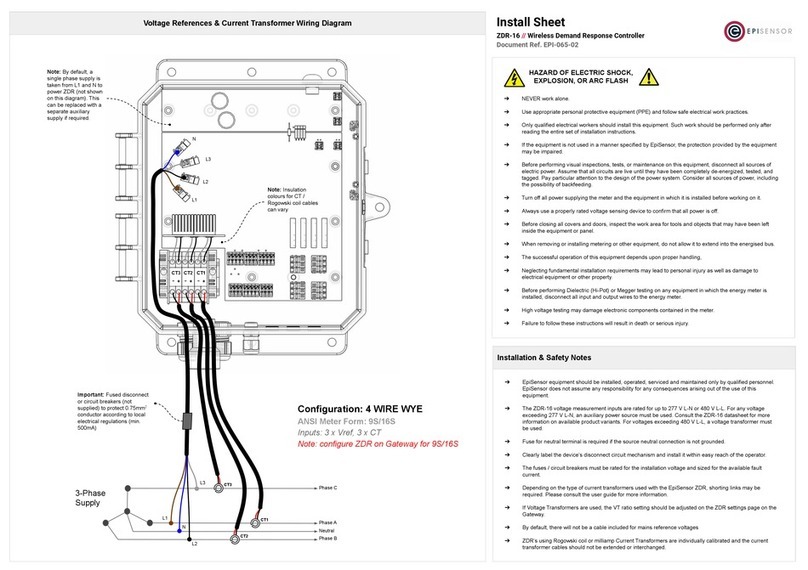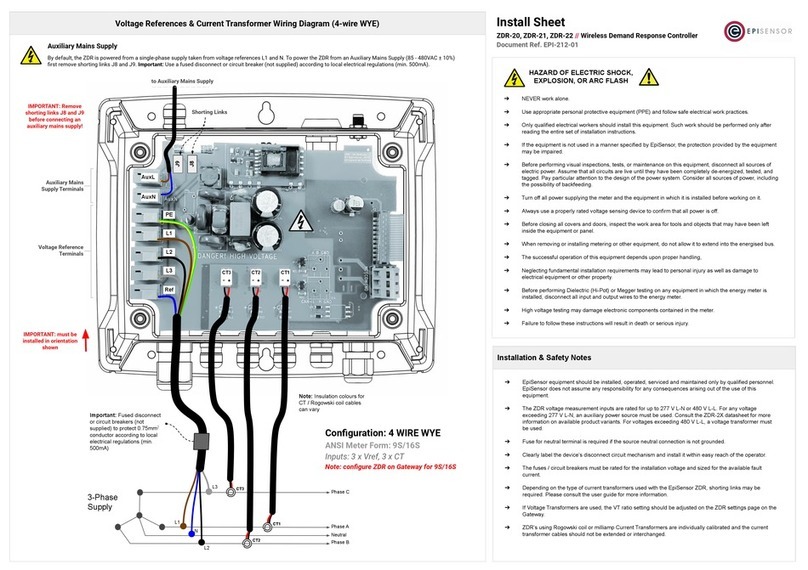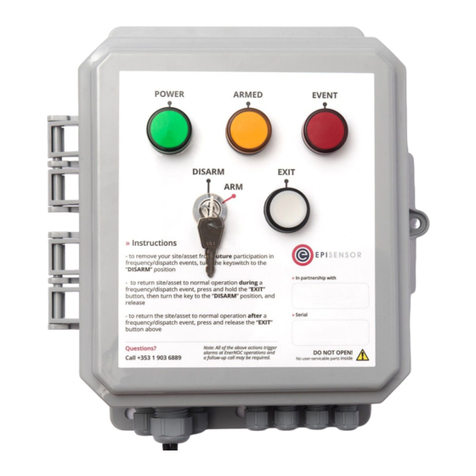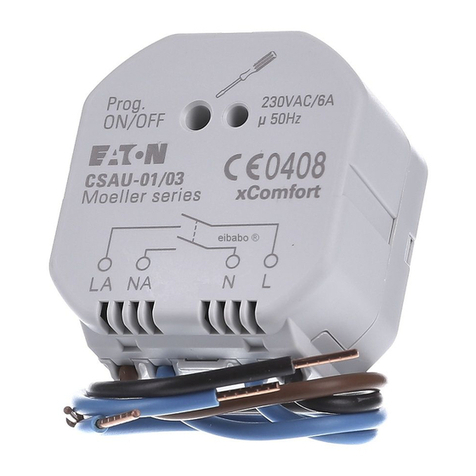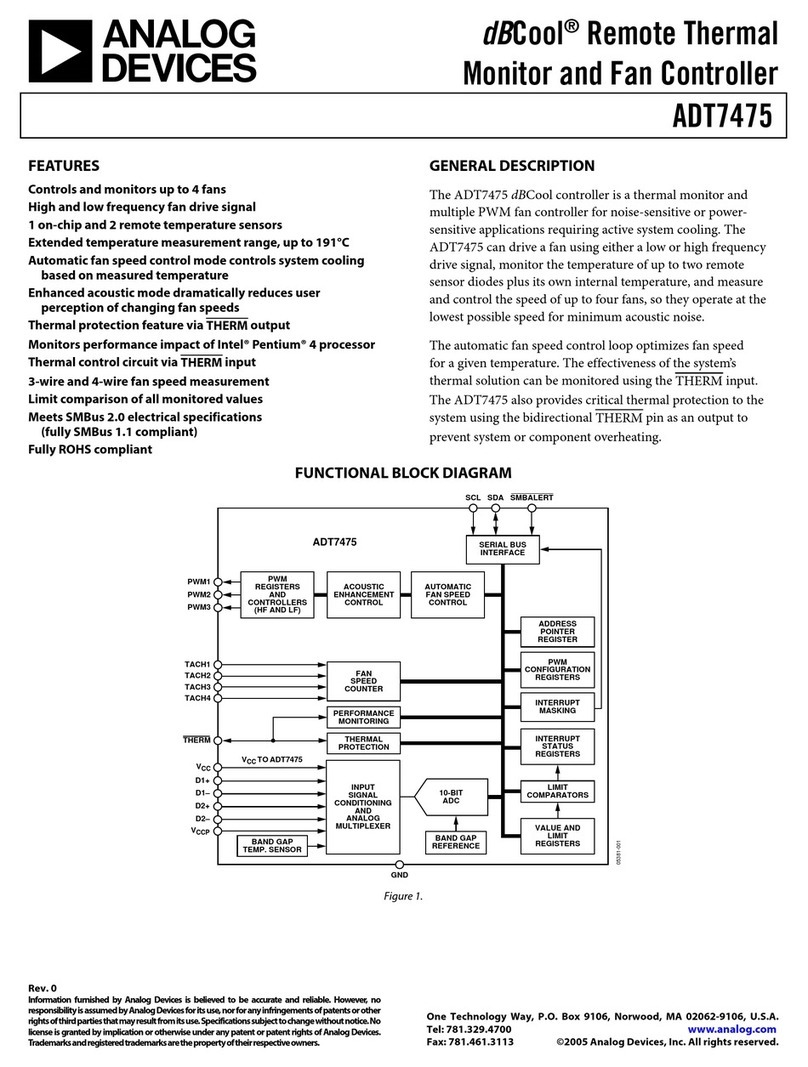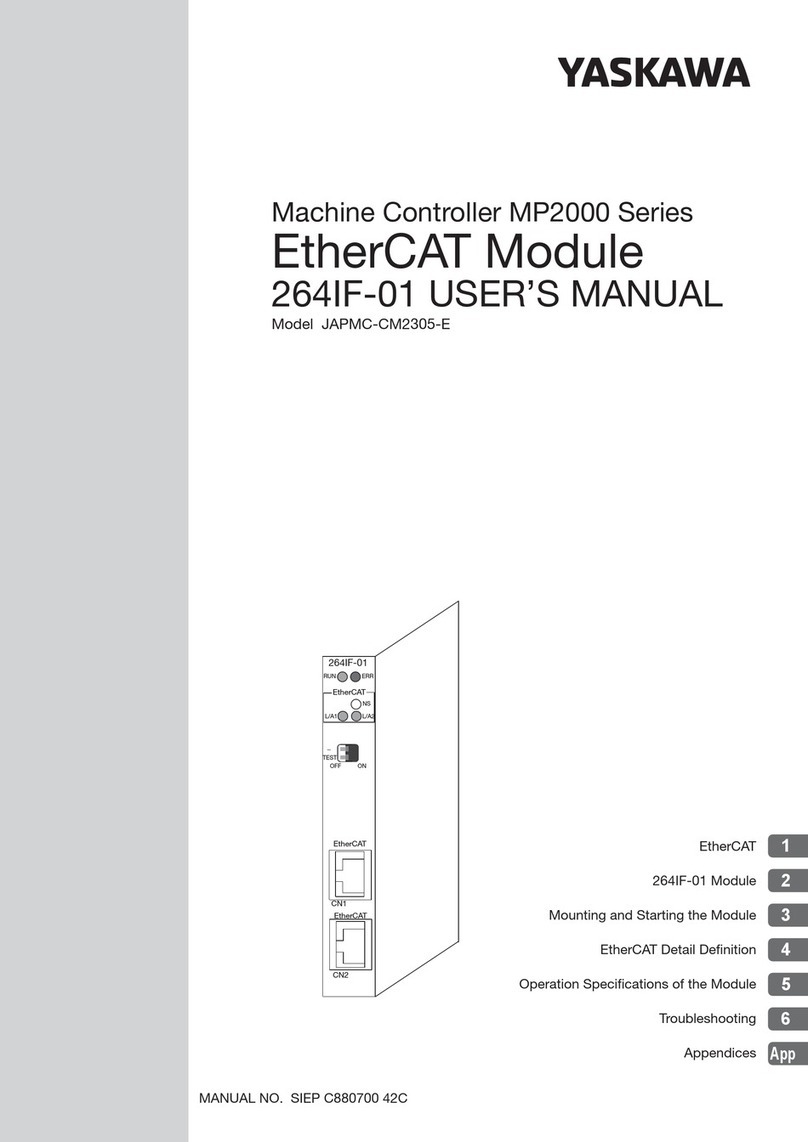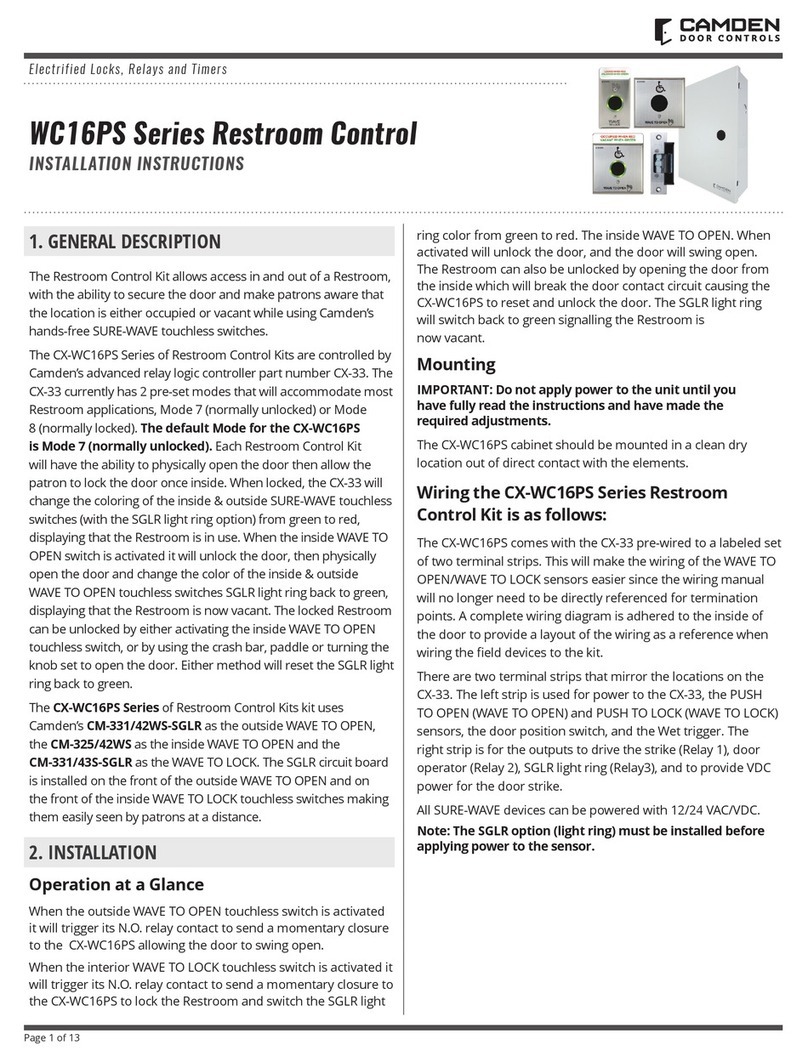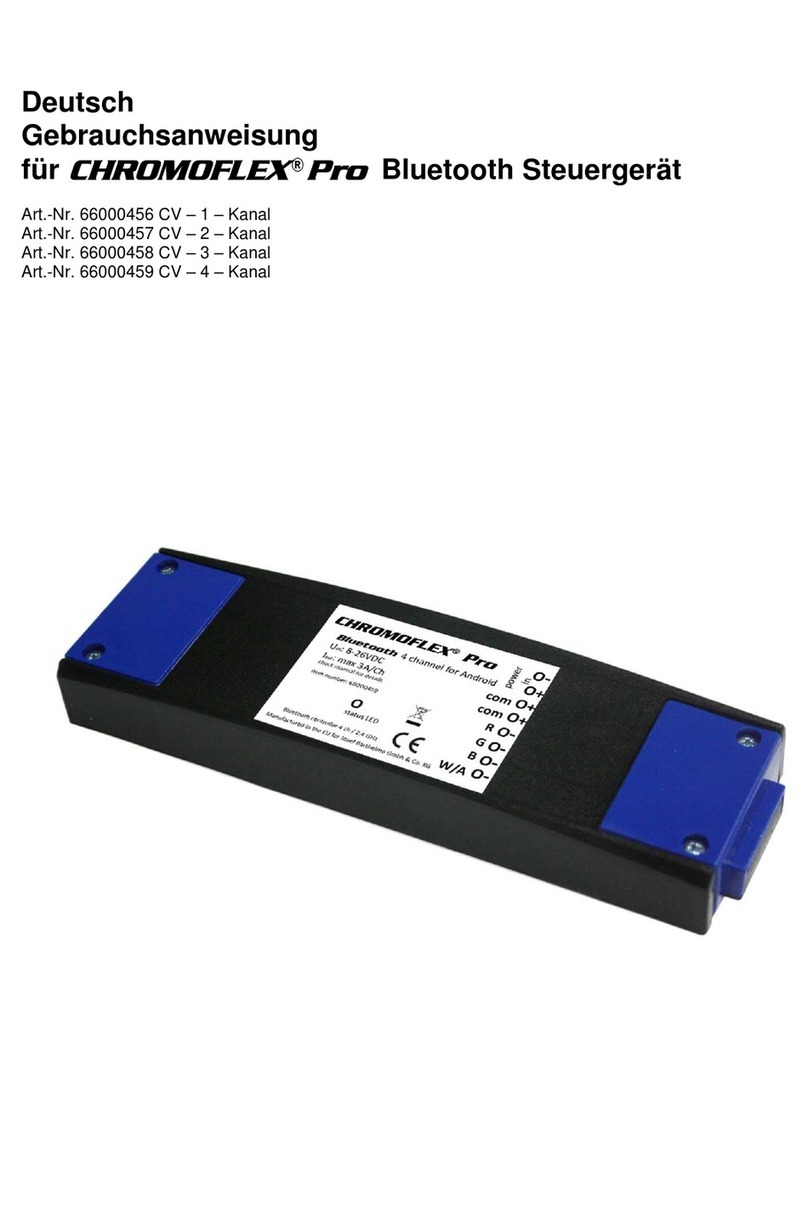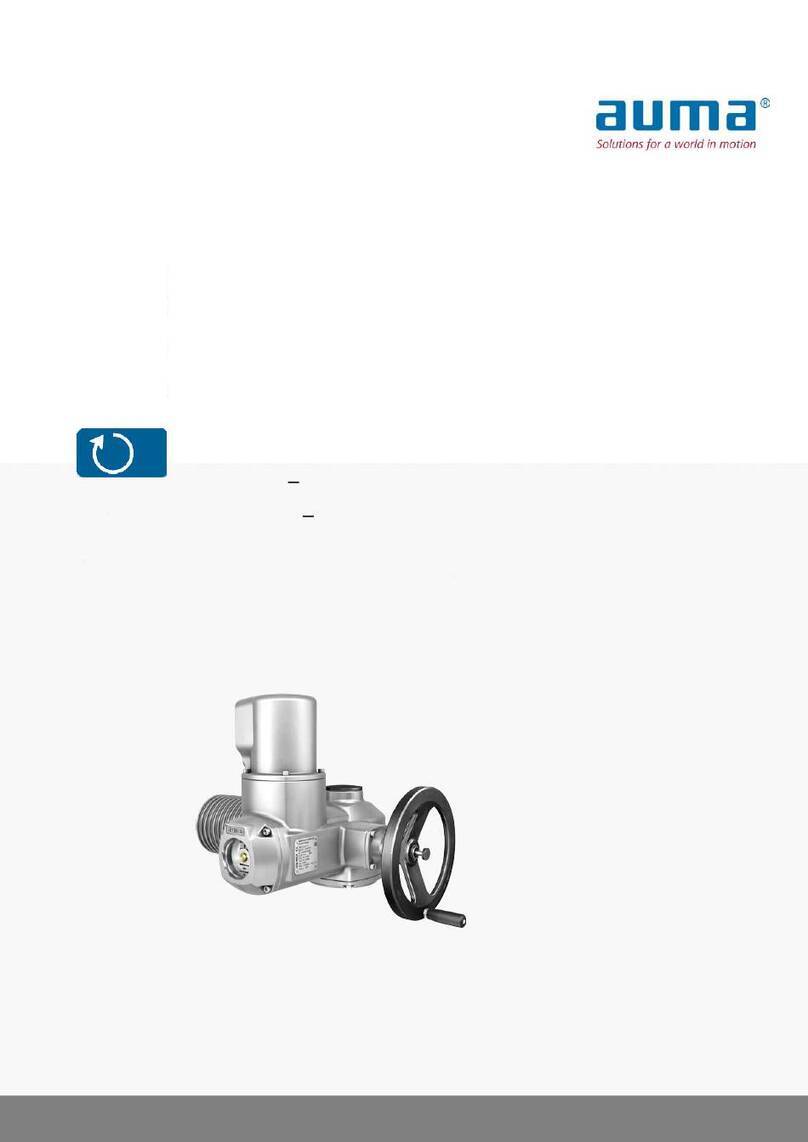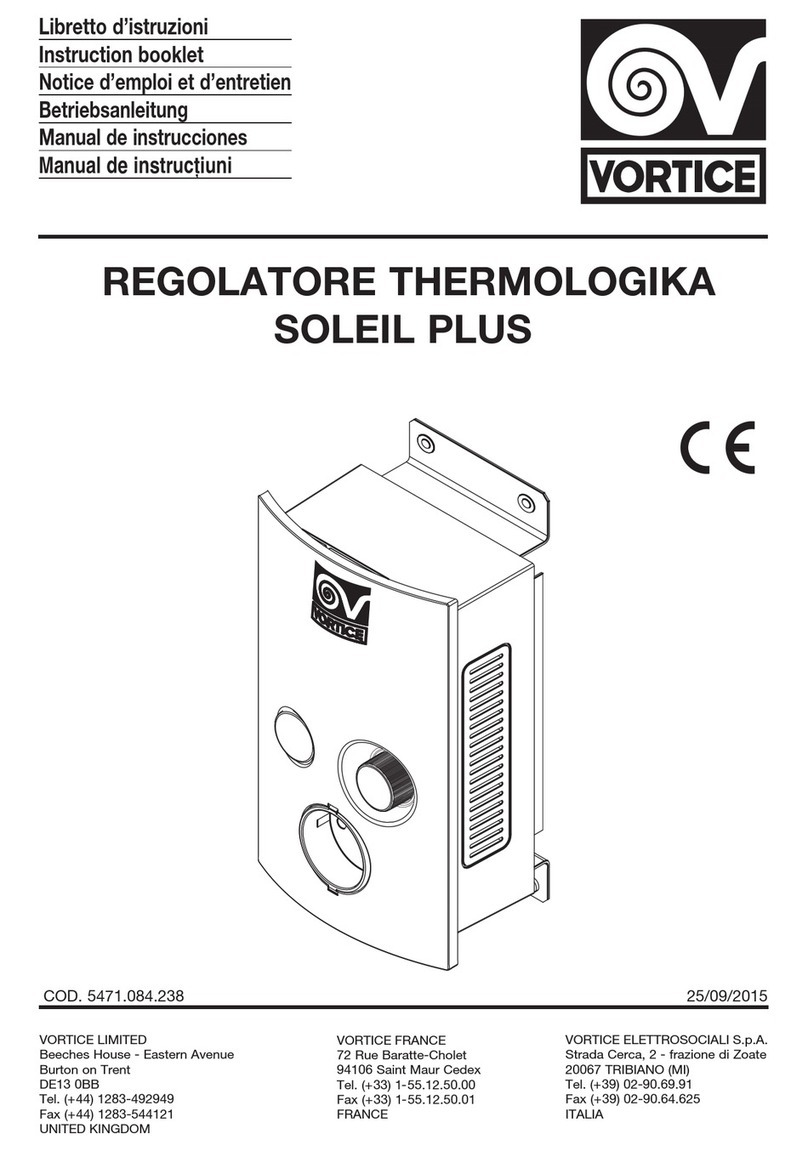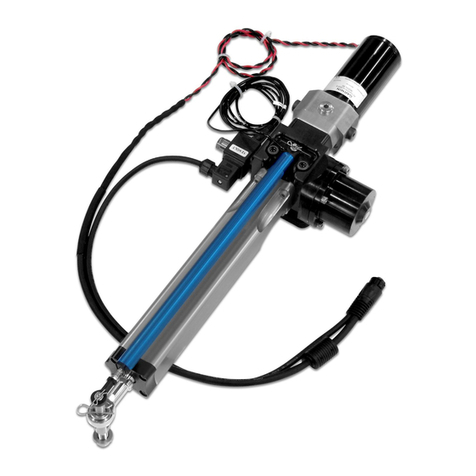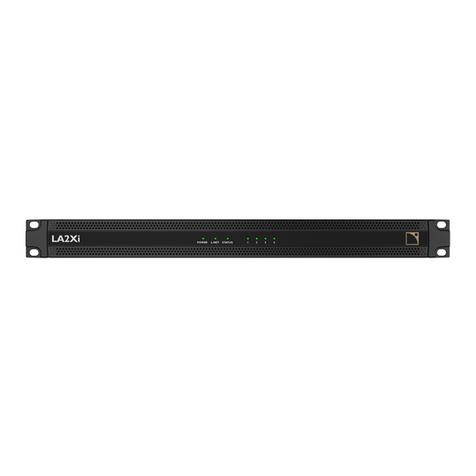EpiSensor ZDR-15 User manual

User Guide
Wireless Demand Response Controller
Applies to: ZDR-10, ZDR-15, ZDR-16, ZDR-17
EPI-078-03
© EpiSensor

Table of Contents
Safety Information 5
Electrical Installation 5
Intended Use 7
Related Documents 7
Introduction 8
Benefits 8
Features 8
Data Feeds & Settings 9
Frequency Response Settings 9
General Settings 11
Frequency Analysis, Property 6552 12
Voltage to Current Datapath, Property 6554 13
Meter Configuration, Property 6036 13
System State Sensors 13
Event Response Sensors 14
User Interface Sensors 15
Electricity Metering Sensors 16
Analogue & Digital Inputs 17
Modbus Sensors 18
Network and Zigbee Sensors 20
Frequency Response Specification 20
Reaction Time 20
User Interface 21
Status LED 21
Mode Button 22
Install Mode 22
Page 2of 46

Front Panel 23
Demand Response Logic 24
Rules Engine 24
Remote Management 25
Gateway API 25
Firmware Updates 25
Hardware Features 26
Power Supply 27
Communications 28
Wireless Communications 30
Electricity Metering 31
Electricity Metering 32
Current Transformers 32
Rogowski Coils 33
Supported 3-phase configurations 34
Voltage Reference 35
Switch Output 36
Analogue Inputs 36
Digital Inputs 37
Pulse Info 37
Pulse Operation 38
Dry Pulse 38
Open Collector Pulse 38
Active Pulse 39
Mechanical 39
Enclosure & Label Material 39
Mounting Instructions 39
Opening the Enclosure 40
Tamper Evident Seals 41
Page 3of 46

Safety Information
Please read these instructions carefully before trying to install, operate, service or maintain the ZDR. The
following special notes may appear throughout the user guide (or on the equipment labels) to warn of potential
hazards or to call attention to information that clarifies or simplifies a procedure for users.
Symbol
Description
The addition of either symbol to a “Danger” or “Warning” safety label indicates that an
electrical hazard exists which will result in personal injury if the instructions are not
followed.
This is the safety alert symbol. It is used to alert you to potential personal injury hazards.
Obey all safety messages that follow this symbol to avoid possible injury or death.
This symbol notes that Electrostatic discharge (ESD) events can harm electronic components
inside this product. Protect against ESD and discharge static electricity from your body
before you interact with this product.
Electrical Installation
Electrical equipment should be installed, operated, serviced and maintained only by qualified personnel. No
responsibility is assumed by EpiSensor for any consequences arising out of the use of this material.
A qualified person is one who has skills and knowledge related to the construction, installation, and operation of
electrical equipment and has received safety training to recognize and avoid the hazards involved.
Installation, wiring, testing and service must be performed in accordance with all local and national electrical
codes.
HAZARD OF ELECTRIC SHOCK, EXPLOSION, OR ARC FLASH
➔NEVER work alone.
➔Use appropriate personal protective equipment (PPE) and follow safe electrical work practices.
➔Only qualified electrical workers should install this equipment. Such work should be performed only
after reading the entire set of installation instructions.
Page 5of 46

➔If the equipment is not used in a manner specified by EpiSensor, the protection provided by the
equipment may be impaired.
➔Before performing visual inspections, tests, or maintenance on this equipment, disconnect all sources
of electric power. Assume that all circuits are live until they have been completely de-energized,
tested, and tagged. Pay particular attention to the design of the power system. Consider all sources of
power, including the possibility of backfeeding.
➔Turn off all power supplying the meter and the equipment in which it is installed before working on it.
➔Always use a properly rated voltage sensing device to confirm that all power is off.
➔Before closing all covers and doors, inspect the work area for tools and objects that may have been
left inside the equipment or panel.
➔When removing or installing metering or other equipment, do not allow it to extend into the
energised bus.
➔The successful operation of this equipment depends upon proper handling,
➔Neglecting fundamental installation requirements may lead to personal injury as well as damage to
electrical equipment or other property.
➔Before performing Dielectric (Hi-Pot) or Megger testing on any equipment in which the energy meter
is installed, disconnect all input and output wires to the energy meter.
➔High voltage testing may damage electronic components contained in the meter.
➔Failure to follow these instructions will result in death or serious injury.
Installation & Safety Notes
➔EpiSensor equipment should be installed, operated, serviced and maintained only by qualified
personnel. EpiSensor does not assume any responsibility for any consequences arising out of the use
of this equipment.
➔The ZDR voltage measurement inputs are rated for up to 250 V L-N or 433 V L-L. For any voltage
exceeding 250 V L-N, an auxiliary power source must be used. Consult the ZDR datasheet for more
information on available product variants. For voltages exceeding 433 V L-L, a voltage transformer
must be used.
Page 6of 46

➔Fuse for neutral terminal is required if the source neutral connection is not grounded.
➔Clearly label the device’s disconnect circuit mechanism and install it within easy reach of the operator.
➔The fuses / circuit breakers must be rated for the installation voltage and sized for the available fault
current.
➔If Voltage Transformers are used, the power consumption values must be adjusted in ZDR settings
accordingly.
➔Each ZDR meter is individually calibrated and the current transformer cables should not be extended
or interchanged.
Intended Use
Do not use this device for critical control or protection applications where human or equipment safety relies on
the operation of the control circuit. Failure to follow these instructions can result in death, serious injury, or
equipment damage.
Warning
This is a class A product. In a domestic environment this product may cause radio
interference in which case the user may be required to take adequate measures.
Related Documents
Related installation and configuration documents are listed in the following table:
Document
Reference No.
EpiSensor ZDR Datasheet
EPI-066-00
Install Sheet for ZDR
EPI-065-00
Gateway API User Guide
ESE-009-08
Bootloading on a live Gateway
EPI-064-00
Configuring the High Speed Data Module on ZDR
EPI-131-02
Page 7of 46

Application Note - Demand Response Event Data
EPI-124-01
Introduction
EpiSensor’s ZDR enables customers to participate in multiple Demand and Frequency response programs. It
includes best-in-class functionality to accurately monitor electrical load (via CT’s or pulse inputs), frequency and
can take action to shed load or engage backup generators based on frequency set points or commands sent from
a remote network operations centre.
The system is capable of streaming data securely to a Network Operations Centre (NOC) to arm the system,
detect low frequency events, override the system remotely, and switch loads both automatically and manually.
With a wide range of additional sensors available, EpiSensor’s platform can also be used for energy
management, environmental monitoring and many other applications.
This guide discusses features of the EpiSensor ZDR series demand response controller and provides installation
and configuration instructions.
For the most up-to-date version of this document and others, please visit www.episensor.com
Benefits
●Significantly lower cost and physical size than other solutions
●Can be expanded to multiple ‘apps’ with additional sensors available
●Multiple ZDR’s can communicate to a single Gateway
Features
●4 relays for asset control
●2-channel high frequency pulse inputs
●2-channel 4-20mA analog inputs
●100ms reaction time for under frequency events
●Live stream (1-second) data for 3-phase power consumption, current and frequency
●Modbus (RS-485) communications capability
Page 8of 46

Data Feeds & Settings
The list of parameters that are available to monitor on the ZDR are listed below. Data reporting can be enabled
or disabled as required for each of the ‘sensors’ below.
Frequency Response Settings
Single Channel ZDR-16 [One Switch and one Event Value Affecting 4 Relays Concurrently]
The following table lists the settings on the ZDR that relate to frequency response. They define how the ZDR
should respond to under-frequency events and how the current state of the hardware. These items are
configured as properties on the ZDR rather than sensors.
Property ID
Setting
Description
Unit
Resolution
Reporting
Default
Read/Write
6500
Event Sensor
The sensor ID for which the system is
monitoring to generate events.
Initially this is only configurable for
“none” indicating no events are
generated locally, or “Line Frequency
- 342” for frequency monitoring.
-
-
-
none
Read/Write
6501
Enter Event Value
The value at which the system will
trigger the start of an event.
Raw Sensor
Units
1
-
49700
Read/Write
6502
Exit Event Value
The value at which the system will
exit the event.
Raw Sensor
Units
1
-
49800
Read/Write
Four Channel ZDR [4 Relays - 2 for Frequency Response with Independent Upper and Lower
Enter/Exit Event Values, 2 for Demand Response]
The following table lists the settings on the ZDR that relate to frequency response.
Property ID
Setting
Description
Unit
Resolution
Reporting
Default
Read/Write
6507
Remotely Armed
Is the system configured for
Frequency Monitoring. If FALSE, It
may still be locally armed with the
key switch for Demand Response
Events.
Boolean
1
-
none
Read/Write
The Enter and Exit Event Values for the 4 channel ZDR-16 are contained within the Sensor Settings for Relay 1
(Sensor ID 71) and Relay 2 (Sensor ID 72). Relay 3 and Relay 4 are reserved for Demand Response functions only
and are not configurable for Frequency Response. Similarly, Relay 1 and Relay 2 are reserved for Frequency
Response only and are not configurable for Demand Response.
Relays 1 and 2 use the following sensor level settings to configure the Enter and Exit Event Values.
Property ID
Setting
Description
Unit
Resolution
Reporting
Default
Read/Write
6490
High Enter Event
Value
The value at which the system will
trigger the start of an event when
Hz
0.001
-
50.300
Read/Write
Page 9of 46

the frequency is above nominal
6491
High Exit Event
Value
The value at which the system will
trigger the end of an event when the
frequency is above nominal
Hz
0.001
-
50.200
Read/Write
6492
Low Exit Event
Value
The value at which the system will
trigger the end of an event when the
frequency is below nominal
Hz
0.001
-
49.800
Read/Write
6493
Low Enter Event
Value
The value at which the system will
trigger the start of an event when
the frequency is below nominal
Hz
0.001
-
49.700
Read/Write
Single Channel ZDR-17 [One Event Value Affecting Battery Output on a Stepped Basis]
The following table lists the settings on the ZDR that relate to frequency response. They define how the ZDR
should respond to under-frequency events and how the current state of the hardware. These items are
configured as properties on the ZDR rather than sensors.
Property ID
Setting
Description
Unit
Resolution
Reporting
Default
Read/Write
6507
Remotely Armed
Is the system configured for
Frequency Monitoring and Battery
Control.
Boolean
1
-
none
Read/Write
6501
Enter Event Value
The value at which the system will
trigger the start of an event. Used by
the High Speed Module to monitor
Frequency Events
Hz
0.001
-
49.700
Read/Write
6502
Exit Event Value
The value at which the HSDM will
determine that an event has ended.
Hz
0.001
-
49.800
Read/Write
6510
dFFR Start
Frequency
The Frequency at which the ZDR-17
will start to request power from the
Battery
Hz
0.001
-
49.900
Read/Write
6511
dFFR Step Count
The max number of steps in the
frequency profile
-
-
-
10
Read/Write
6512
dFFR Frequency
Step Size
The step size for each increase in
energy requested from the battery
Hz
0.001
-
0.200
Read/Write
6513
dFFR Energy Per
Step
The increase in energy per step of
frequency
UOM based
on Sensor
249
-
-
-
Read/Write
6514
dFFR Maximum
Event Time
The max time the ZDR-17 will
request power from the battery
seconds
1
-
120
Read/Write
6515
dFFR Battery
Enable Function
The Modbus code sent to Sensor ID
48 to start the Battery Discharge.
Battery Function minus one is the
disable function to stop the
discharge.
-
-
-
0
Read/Write
Page 10 of 46

General Settings
6503
Auto Exit
Defines whether the site will exit a
trip state automatically after an
event, or if it should wait for a ‘soft
reset’ from a user via the
pushbutton.
TRUE
/FALSE
1
-
0
Read/Write
6508
Pre Event Log Time
The number of seconds the HSDM
should record before the event. The
total event time is 30 seconds so
increasing this value reduces the
post event log time
seconds
1
-
5
Read/Write
6504
Minimum Event
Time
The minimum time the event must
stay active, even if the frequency, or
demand response returns to a good
state
seconds
1
-
0
Read/Write
6505
Event Reset Time
The minimum time after the event
when the ZDR will not allow another
event to start giving the site time to
recover
seconds
1
-
0
Read/Write
6506
Filter Sample Count
The number of sequential “Start of
Event” readings that are inside the
“Enter Event Value” before an event
is considered “real”. Readings are
taken 20ms apart
units
1
-
10
Read/Write
6552
Frequency Analysis
The meaning of the Frequency
Analysis Sensors - 330, 331 and 332.
See further explanation below
-
-
-
Power
Factor
Read/Write
6553
CT Direction
A setting allowing the CT direction to
be inverted. Useful in the case where
one or more CTs have been installed
in reverse
-
-
-
Fwd
Read/Write
6554
Voltage to Current
Datapath
This allows the ZDR to redirect the
Voltage from any channel into the
datapath for KW and KWH of
another.
-
-
-
A-B-C
Read/Write
6556
CT Phase Angle
An correction angle applied if the CT
introduces a known error angle on
the channel
seconds
1
-
0
Read/Write
6555
VT Phase Angle
An correction angle applied if a VT
introduces a known error angle on
the channel
seconds
1
-
0
Read/Write
6551
CT Ratio
A multiplier on the CT input channel
which is applied to the calibration
constants within the metering
section of the ZDR System. It allows
for 100:1 or 100:5 (20:1) type Ratios
to be applied to the CTs
-
-
-
1
Read/Write
6550
VT Ratio
A multiplier on the VT input channel
which is applied to the calibration
constants within the metering
section of the ZDR System. It allows
the ZDR to be connected to MV
systems with (for example) 11kV
inputs using VTs that output 110V.
-
-
-
1
Read/Write
Page 11 of 46

6557
Voltage
Measurement
Range
A setting allowing the ZDR to read
low range voltages, or high range
voltages by applying a different gain
factor to the voltage channels
VAC (L-L)
-
-
120 -
600
Read/Write
6036
Configuration
The American ANSI C12.10 standard
defines the different configurations
of the meter. This defines how the
active power accumulated in each
watt-hour register is calculated.
-
-
-
9S/16S
4-wire
Wye
Read/Write
6034
Nominal Frequency
The nominal frequency of the system
being monitored. Only used when
selecting the correct injection test
for the current line frequency range.
Hz
-
-
50
Read/Write
6558
Injection Test
Profile
A series of frequency profiles that
can be used to test the ZDR
Response
-
-
-
-
Read/Write
6410
Modbus Baud Rate
RS485 Communication Parameter for
Modbus Network
-
-
-
-
Read/Write
6411
Modbus Parity
RS485 Communication Parameter for
Modbus Network
-
-
-
-
Read/Write
6412
Modbus Stop Bits
RS485 Communication Parameter for
Modbus Network
-
-
-
-
Read/Write
Frequency Analysis, Property 6552
Configuration
Meaning
Sensor 330
Sensor 331
Sensor 332
Power Factor
Using the Phase Angle
between Voltage and
Current to calculate the
Power Factor for the
Phase
Phase A Power Factor
Phase B Power Factor
Phase C Power Factor
Voltage to Current
Phase Angle
Phase Angle between
Voltage and Current
Phase Angle delay
between Phase A
voltage and Current
Phase Angle delay
between Phase B
Voltage and Current
Phase Angle delay
between Phase C
Voltage and Current
Voltage to Voltage
Phase Angle
The Phase Angle
between various
Voltage Waveforms
Phase Angle Delay
between Phase A
Voltage and Phase C
Voltage
Phase Angle Delay
between Phase B
Voltage and Phase C
Voltage
Phase Angle Delay
between Phase A
Voltage and Phase B
Voltage
Current to Current
Phase Angle
The Phase Angle
between various
Current Waveforms
Phase Angle Delay
between Phase A
Current and Phase C
Current
Phase Angle Delay
between Phase B
Current and Phase C
Current
Phase Angle Delay
between Phase A
Current and Phase B
Current
Page 12 of 46

Voltage to Current Datapath, Property 6554
The ZDR can direct one phase voltage input to the computational datapath of another phase. For example, Phase
A voltage can be introduced in the Phase B computational datapath, which means all powers computed by the
ZDR in Phase B are based on Phase A voltage and Phase B current.
Configuration
Meaning
Phase A Powers
Phase B Powers
Phase C Powers
A-B-C
All channels lined up
VA and IA
VB and IB
VC and IC
A-C-B
B and C swapped
VA and IA
VC and IB
VB and IC
B-A-C
B and A swapped
VB and IA
VA and IB
VC and IC
B-C-A
Phases Rotated “left”
VB and IA
VC and IB
VA and IC
C-A-B
Phases Rotated “right”
VC and IA
VA and IB
VB and IC
C-B-A
A and C Swapped
VC and IA
VB and IB
VA and IC
Meter Configuration, Property 6036
The active power accumulated in each watt-hour sensor depends on the configuration of the Meter. Choose the
appropriate value from the table below depending on how the ZDR is connected to a 3-phase system. This is
based on the ANSI C12.10 standard.
Ansi Meter Form
Configuration
Phase A Watt Hours
Phase B Watt Hours
Phase C Watt Hours
9S/16S
4-wire wye
VA x IA
VB x IB
VC x IC
5S/13S
3-wire delta
VA x IA
0
VC x IC
6S/14S
4-wire wye
VA x IA
VB × IB
Where VB = −VA − VC
VC x IC
8S/15S
4-wire delta
VA x IA
VB × IB
Where VB = −VA
VC x IC
System State Sensors
These sensors provide data on the state of the ZDR State Variables and can be used to trigger state changes at
the NOC or for audit/compliance purposes.
Sensor ID
Data Feed
Description
Unit
Resolution
Reporting
Default
Read/Write
20
Armed 1 (On 4
channel ZDR-16
only)
Set to 1 when the Key Switch is in
the Armed position AND Remotely
Armed property is TRUE so
Frequency Response is active on
Relay 1. Set to 0 otherwise.
1/0
1
Interval
and Delta
-
Read Only
Page 13 of 46

21
Armed 2 (On 4
channel ZDR-16
only)
Set to 1 when the Key Switch is in
the Armed position AND Remotely
Armed property is TRUE so
Frequency Response is active on
Relay 2. Set to 0 otherwise.
1/0
1
Interval
and Delta
-
Read Only
22
Armed 3 (On 4
channel ZDR-16
only)
Set to 1 when the Key Switch is in
the Armed position so Demand
Response is available on Relay 3. Set
to 0 otherwise.
1/0
1
Interval
and Delta
-
Read Only
23
Armed 4 (On 4
channel ZDR-16
only)
Set to 1 when the Key Switch is in
the Armed position so Demand
Response is available on Relay 4. Set
to 0 otherwise.
1/0
1
Interval
and Delta
-
Read Only
24
Armed (On single
channel ZDR-16
and ZDR-17)
Set to 1 when the Key Switch is in
the Armed position AND the ZDR
system is actively monitoring an
Event Sensor. Set to 0 otherwise.
1/0
1
Interval
and Delta
-
Read Only
25
Opt Out
Set to 1 when the Gateway or API
removes a device from an active
event with the Opt Out command
OR when a user on site has removed
the site from an event by the Opt
Out key sequence on the front panel
- Press and hold the Exit button and
turn the key switch to Disarm.
1/0
1
Interval
and Delta
-
Read Only
Event Response Sensors
The following sensors produce data on the state of the ZDR showing whether an event is currently in progress, or
if the ZDR has been triggered remotely by the NOC.
Sensor ID
Data Feed
Description
Unit
Resolution
Reporting
Default
Read/Write
27
Event Response
Notifies that an event is currently in
progress. Will be reset if a user takes
the site out of trip with the
pushbutton and keylock, or with
remote override. Or if the event
ends and the system is configured to
Auto Exit
1/0
1
Interval
and Delta
-
Read Only
26
Demand Response
Notifies that a demand response
event is currently in progress. Will be
reset either by the manual override
push button, or remote override. Or
if the event ends and the system is
configured to Auto Exit
1/0
1
Interval
and Delta
-
Read Only
359
Switch (On single
channel ZDR-16
only)
The position of the switch. Writing 1
to the switch initiates a DR Event,
while writing 0 to the switch ends a
DR Event. Note that the switch could
be ON, when no event is in progress
if the system is waiting for a manual
Exit.
1/0
1
Interval
and Delta
-
Read/Write
Page 14 of 46

71
Relay 1 (On 4
channel ZDR-16
only)
The position of the RL1 Relay. This
Relay is for FR Events only so cannot
be set externally. Note that the
switch could be ON, when no event
is in progress if the system is waiting
for a manual Exit.
1/0
1
Interval
and Delta
-
Read/Write
72
Relay 2 (On 4
channel ZDR-16
only)
The position of the RL2 Relay. This
Relay is for FR Events only so cannot
be set externally. Note that the
switch could be ON, when no event
is in progress if the system is waiting
for a manual Exit.
1/0
1
Interval
and Delta
-
Read/Write
73
Relay 3 (On 4
channel ZDR-16
only)
The position of the RL3 Relay.
Writing 1 to the Relay 3 initiates a DR
Event, while writing 0 to the switch
ends a DR Event. Note that the
switch could be ON, when no event
is in progress if the system is waiting
for a manual Exit.
1/0
1
Interval
and Delta
-
Read/Write
74
Relay 4 (On 4
channel ZDR-16
only)
The position of the RL4 Relay.
Writing 1 to the Relay 4 initiates a DR
Event, while writing 0 to the switch
ends a DR Event. Note that the
switch could be ON, when no event
is in progress if the system is waiting
for a manual Exit.
1/0
1
Interval
and Delta
-
Read/Write
User Interface Sensors
These sensors provide data on the state of the user interface and can be used to trigger state changes at the
NOC or for audit/compliance purposes.
Sensor ID
Data Feed
Description
Unit
Resolution
Reporting
Default
Read/Write
41
Key Switch
The position of the key switch. 1 =
Armed, 0 = Not Armed
-
1
Interval
and Delta
-
Read Only
42
Exit Button
The position of the Exit Button, 1 =
pressed, 0 = released
-
1
Interval
and Delta
-
Read Only
250
Enter Event Value
(On single channel
ZDR-16 and
ZDR-17)
An Echo of the Enter Event Value
Property 6501 which allows this to
be exported as a Sensor in the
normal fashion
-
1
Snap to
Clock
-
Read Only
251
Exit Event Value
(On single channel
ZDR-16 and
ZDR-17)
An Echo of the Exit Event Value
Property 6502 which allows this to
be exported as a Sensor in the
normal fashion
-
1
Snap to
Clock
-
Read Only
252
Relay 1 High Enter
Event Value (On 4
channel ZDR-16
only)
An Echo of the High Enter Event
Value Property 6490 On Relay 1
which allows this to be exported as a
Sensor in the normal fashion
-
1
Snap to
Clock
-
Read Only
253
Relay 1 High Exit
Event Value (On 4
channel ZDR-16
only)
An Echo of the High Exit Event Value
Property 6491 On Relay 1 which
allows this to be exported as a
Sensor in the normal fashion
-
1
Snap to
Clock
-
Read Only
Page 15 of 46

254
Relay 1 Low Exit
Event Value (On 4
channel ZDR-16
only)
An Echo of the Low Exit Event Value
Property 6492 On Relay 1 which
allows this to be exported as a
Sensor in the normal fashion
-
1
Snap to
Clock
-
Read Only
255
Relay 1 Low Enter
Event Value (On 4
channel ZDR-16
only)
An Echo of the Low Enter Event
Value Property 6493 On Relay 1
which allows this to be exported as a
Sensor in the normal fashion
-
1
Snap to
Clock
-
Read Only
256
Relay 2 High Enter
Event Value (On 4
channel ZDR-16
only)
An Echo of the High Enter Event
Value Property 6490 On Relay 2
which allows this to be exported as a
Sensor in the normal fashion
-
1
Snap to
Clock
-
Read Only
257
Relay 2 High Exit
Event Value (On 4
channel ZDR-16
only)
An Echo of the High Exit Event Value
Property 6491 On Relay 2 which
allows this to be exported as a
Sensor in the normal fashion
-
1
Snap to
Clock
-
Read Only
258
Relay 2 Low Exit
Event Value (On 4
channel ZDR-16
only)
An Echo of the Low Exit Event Value
Property 6492 On Relay 2 which
allows this to be exported as a
Sensor in the normal fashion
-
1
Snap to
Clock
-
Read Only
259
Relay 2 Low Enter
Event Value (On 4
channel ZDR-16
only)
An Echo of the Low Enter Event
Value Property 6493 On Relay 2
which allows this to be exported as a
Sensor in the normal fashion
-
1
Snap to
Clock
-
Read Only
Electricity Metering Sensors
These read-only ‘sensors’ provide data on the power consumption and frequency of the 3-phase system that the
ZDR is monitoring.
Sensor ID
Data Feed
Description
Unit
Resolution
Reporting
Default
Read/Write
300
Phase A kWh
Phase A kWh value. This is a
continually increasing kWh reading.
kWh
0.01
Off
-
Read/Write
301
Phase B kWh
Phase B kWh value. This is a
continually increasing kWh reading.
kWh
0.01
Off
-
Read/Write
302
Phase C kWh
Phase C kWh value. This is a
continually increasing kWh reading.
kWh
0.01
Off
-
Read/Write
303
Phase A RMS
Current
Instantaneous Phase A RMS Current.
A
0.1
Off
-
Read Only
304
Phase B RMS
Current
Instantaneous Phase B RMS Current.
A
0.1
Off
-
Read Only
305
Phase C RMS
Current
Instantaneous Phase C RMS Current.
A
0.1
Off
-
Read Only
306
Phase A RMS
Voltage
Instantaneous Phase A RMS Voltage.
V
0.1
Off
-
Read Only
307
Phase B RMS
Voltage
Instantaneous Phase B RMS Voltage.
V
0.1
Off
-
Read Only
308
Phase C RMS
Voltage
Instantaneous Phase C RMS Voltage.
V
0.1
Off
-
Read Only
Page 16 of 46

324
Phase A Active
Power
Instantaneous Active Power on
Phase A
W
1
Off
-
Read Only
325
Phase B Active
Power
Instantaneous Active Power on
Phase B
W
1
Off
-
Read Only
326
Phase C Active
Power
Instantaneous Active Power on
Phase C
W
1
Off
-
Read Only
330
Phase A Power
Factor
Power Factor on Phase A
%
1%
Off
-
Read Only
331
Phase B Power
Factor
Power Factor on Phase B
%
1%
Off
-
Read Only
332
Phase C Power
Factor
Power Factor on Phase C
%
1%
Off
-
Read Only
333
Total kWh
The sum of Phase A, B and C kWh,
sensors 300, 301 and 302
kWh
0.1
Off
-
Read/Write
335
Total Active Power
The instantaneous sum of Phase A, B
and C Active Power, sensors 324, 325
and 326
KW
0.001
Off
-
Read Only
338
Interval Phase A
kWh
The kWh on Phase A since the
previous data point.
kWh
0.01
Off
-
Read/Write
339
Interval Phase B
kWh
The kWh on Phase A since the
previous data point.
kWh
0.01
Off
-
Read/Write
340
Interval Phase C
kWh
The kWh on Phase A since the
previous data point.
kWh
0.01
Off
-
Read/Write
341
Interval Total kWh
The total kWh on all phases since the
previous data point.
kWh
0.1
Off
-
Read/Write
342
Line Frequency
The Line Frequency of the 3 Phase
system. This is read from the Phase A
voltage channel
Hz
0.001
Live
Stream
-
Read Only
Analogue & Digital Inputs
These data feeds show the number of pulses counted by the ZDR and average 4-20mA analogue input readings.
Sensor ID
Data Feed
Description
Unit
Resolution
Reporting
Default
Read/Write
394
4-20 MilliAmps
Now 1
The Instantaneous Milli Amp value
on channel 1 of the 4-20 Milliamp
input.
mA
0.001
Off
-
Read Only
396
4-20 MilliAmps MIn
1
The number of pulses recorded on
channel 2 during the previous
reporting interval.
Ma
0.001
Off
-
Read Only
397
4-20 MilliAmps
Max 1
The average 4-20mA value of
channel 1.
mA
0.001
Off
-
Read Only
Page 17 of 46

494
4-20 MilliAmps
Now 2
The Instantaneous Milli Amp value
on channel 1 of the 4-20 Milliamp
input.
mA
0.001
Off
-
Read Only
496
4-20 MilliAmps MIn
2
The number of pulses recorded on
channel 2 during the previous
reporting interval.
Ma
0.001
Off
-
Read Only
497
4-20 MilliAmps
Max 2
The average 4-20mA value of
channel 1.
mA
0.001
Off
-
Read Only
450
Pulse Count
The total Pulse Count on Channel 1
of the Pulse Input
pulses
1
Off
-
Read/Write
462
Interval Pulse
Count
The total number of Pulses on
channel 1 during the previous
reporting interval
pulses
1
Off
-
Read Only
444
Pulse Rate 1
The instantaneous Pulse Rate on
Channel 1
Hz
0.001
Off
-
Read Only
463
Pulse Count 2
The total Pulse Count on Channel 2
of the Pulse Input
pulses
1
Off
-
Read/Write
464
Interval Pulse
Count 2
The total number of Pulses on
channel 2 during the previous
reporting interval
pulses
1
Off
-
Read Only
447
Pulse Rate 2
The instantaneous Pulse Rate on
Channel 2
Hz
0.001
Off
-
Read Only
Modbus Sensors
The following generic Modbus sensor is available in the 4 channel ZDR-16 and ZDR-17 Only
Sensor ID
Data Feed
Description
Unit
Resolution
Reporting
Default
Read/Write
1100
Modbus Register 0
Generic Modbus Register that can be
used to interface with any connected
Modbus Slave
-
-
Off
-
Read/Write
The following Modbus sensors are available in the ZDR-17 only. They are designed to be used in conjunction with
“Node Profiles” to reconfigure the sensors as “battery specific sensors”. A Modbus Slave is connected to the
ZDR-17 through the RS485 (Modbus) connection and these sensors are read to provide data on the operation of
the battery. The following is the default naming and units of these sensors. They can be renamed, given
different Units of Measure and given different dividers using a node profile.
Sensor ID
Data Feed
Description
Unit
Resolution
Reporting
Default
Read/Write
230
Nominal Capacity
Battery nominal energy capacity
kWh
1
Off
-
Read Only
231
Energy Deliverable
Energy capacity available for up
regulation
kWh
1
Off
-
Read Only
232
Energy Receivable
Energy capacity available for down
regulation
kWh
1
Off
-
Read Only
Page 18 of 46

233
DR Mode Active
Notify external communication that
UPS is in DR mode
-
1
Off
-
Read Only
234
UPS Power Rating
System output power rating
kW
1
Off
-
Read Only
235
Power Deliverable
Maximum power capacity available
for up regulation
kW
1
Off
-
Read Only
236
Power Receivable
Maximum power capacity available
for down regulation
kW
1
Off
-
Read Only
237
Battery Power
Current battery power
kW
1
Off
-
Read Only
238
Rectifier Power
Current Input Power
kW
1
Off
-
Read Only
239
Inverter Power
Current Output Power
kW
1
Off
-
Read Only
240
DR Regulation
Mode
Regulation Mode
-
1
Off
-
Read Only
241
Discharge Time
Remaining
How long the up regulation can be
supplied
seconds
1
Off
-
Read Only
242
Charge Time
Remaining
How long the down regulation can be
supplied
seconds
1
Off
-
Read Only
243
Time Until DR
Remaining
How long it takes until DR mode is
available again
hours
1
Off
-
Read Only
244
Input Frequency
Line Frequency - This may have an
offset defined by the UPS
Hz
1
Off
-
Read Only
245
Phase A Voltage
Measured Input Voltage, Phase A
Volts
1
Off
-
Read Only
246
Phase B Voltage
Measured Input Voltage, Phase B
Volts
1
Off
-
Read Only
247
Phase C Voltage
Measured Input Voltage, Phase C
Volts
1
Off
-
Read Only
248
DR Requested
Value written to UPS to start the
Regulation Mode
-
1
Off
-
Read Only
249
DR Requested
Power
Power written to UPS to request
desired Power
kW
1
Off
-
Read Only
ZDR-17 Special Handling of Sensors 248 and 249
The ZDR-17 is pre-programmed to use Sensors 248 and 249 to control the battery.
1. Sensor 248 is used to Start or Stop discharge, that is to reduce the dependency on the grid and use
battery reserves instead.
2. Sensor 249 is the power value requested from the Battery.
It is important to note that these sensors are not multiplied or divided internally in the ZDR before the values are
written to the UPS/Battery Controller.
Page 19 of 46

The value written to Sensor 248 to start UPS Control is the value contained in Property ID 6515 - dFFR Battery
Enable Function. The value written to Sensor 248 to stop UPS Control is the same value minus one.
The value written to Sensor 249 to define the power required from the UPS is defined by the property 6510,
6511, 6512 and 6513 - those being the Start Frequency, Step Count, Frequency Step Size and Energy Per Step.
Energy Per Step MUST the same Units of Measure as the UPS - This value is not multiplied or divided by the ZDR.
For Example; If the UOM of the UPS is 0.1KW, and the ZDR needs to request 10KW per Step, then Property 6513
should be set to 100. We require 100 * 0.1KW to get 10KW per Step.
Network and Zigbee Sensors
Sensor ID
Data Feed
Description
Unit
Resolution
Reporting
Default
Read/Write
4097
Link Quality
Link Quality % - measure of
Zigbee signal
Off
60
Yes
4099
RSSI
Channel noise in dbm
Off
60
Yes
4101
Neighbour
Count
The number of mains
powered devices this device
can route messages through
Delta
and
Interval
360
Yes
4102
Child Count
The number of battery power
“child” devices that use this
device to route messages
through
Delta
and
Interval
360
Yes
Frequency Response Specification
This section describes the parameters of the ZDR that are particularly important for fast frequency response
programs.
Reaction Time
The reaction time for frequency response programs is defined as the amount of time between an
under-frequency event, and when a relay is latched / asserted.
Some frequency response programs (or the certification for some programs) will require sub-second response
times. The metering chip used in the ZDR samples the voltage waveform regularly to determine the frequency.
The frequency register on the metering chip is polled directly from the ZigBee SoC every 2-3 cycles, which at
50Hz would be every 40ms to 60ms. The main processor then compares the value to the frequency set point,
checks the armed state, and if the ZDR is in fact armed, takes an action to latch a relay.
Page 20 of 46
This manual suits for next models
6
Table of contents
Other EpiSensor Controllers manuals
Popular Controllers manuals by other brands
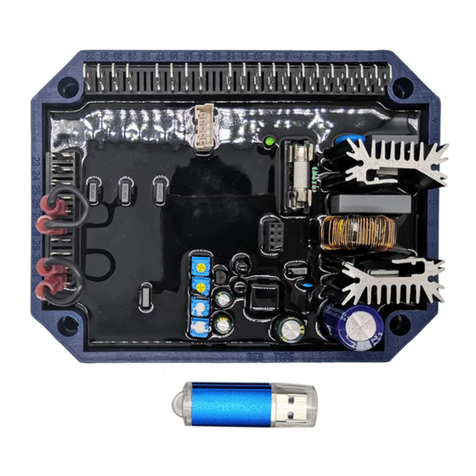
Mecc Alte
Mecc Alte DER1 Technical guide
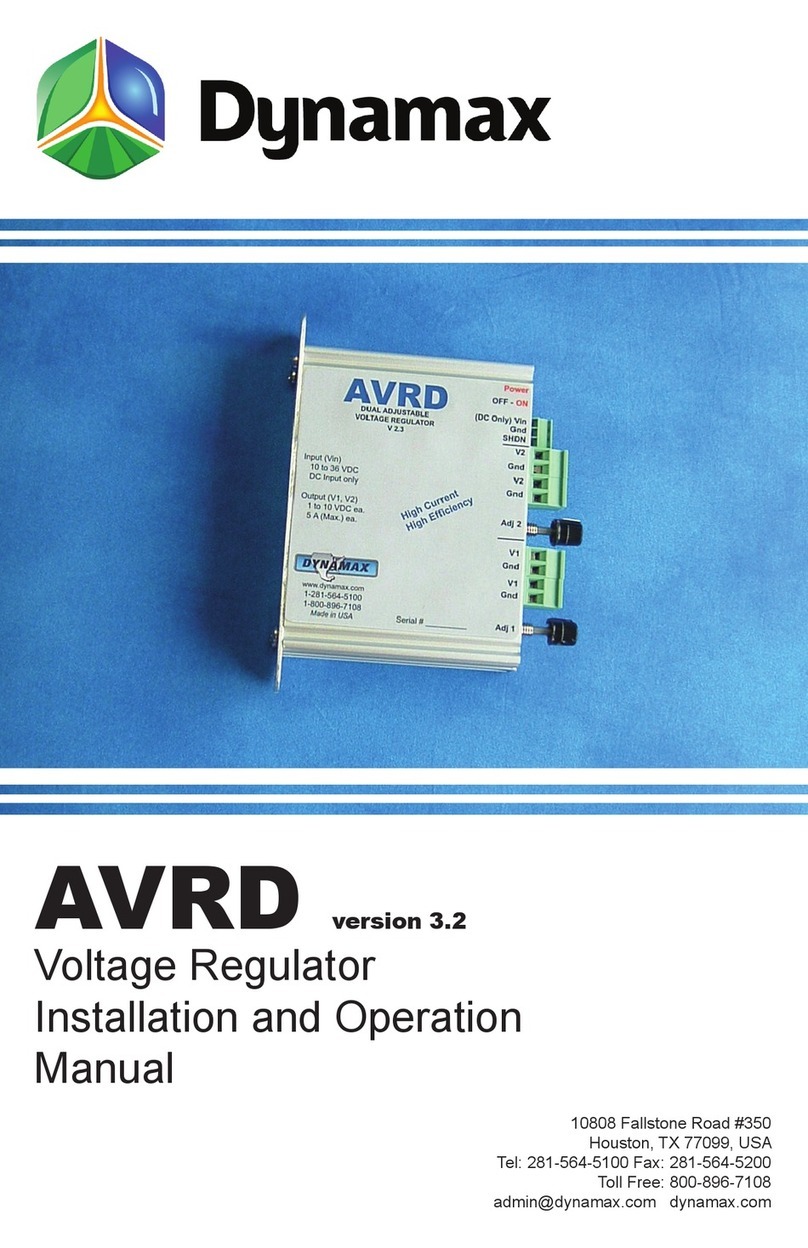
Dynamax
Dynamax AVRD 3.2 Installation and operation manual
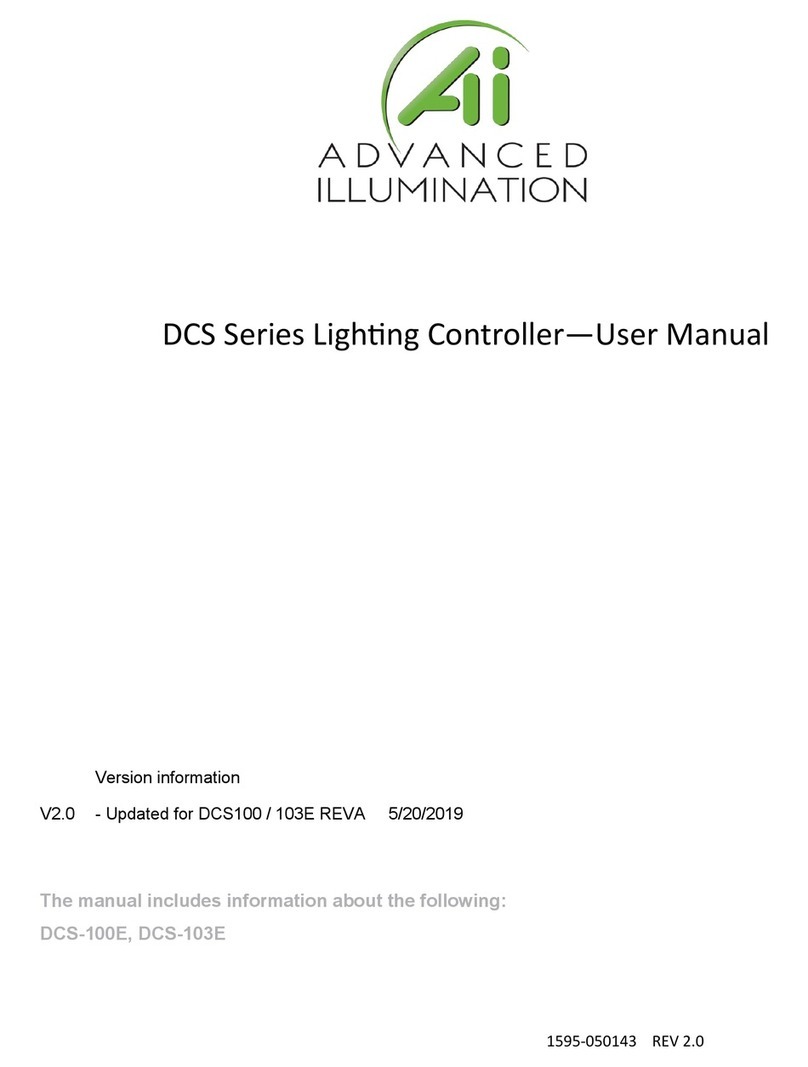
Advanced Illumination
Advanced Illumination DCS Series user manual
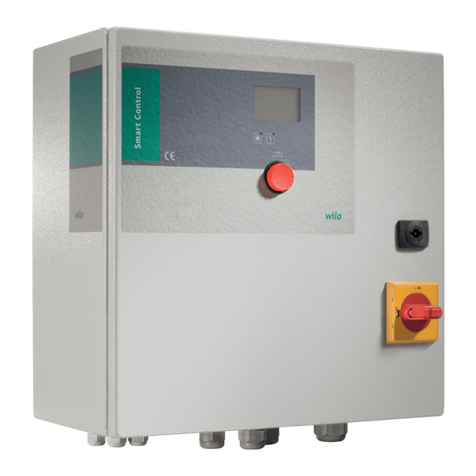
Wilo
Wilo SC-HVAC SC Installation and operating instructions

Tres
Tres 09286405 manual
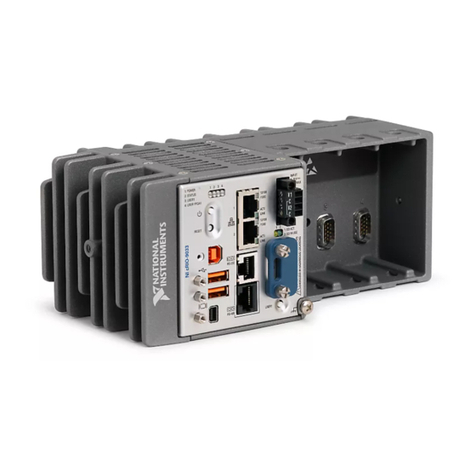
National Instruments
National Instruments cRIO-9031 user manual


